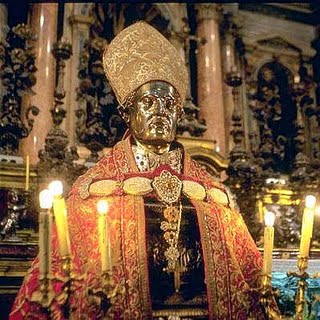 |
St. Januarius (Gennaro) is a patron saint of and former and bishop of Naples
in the 4th century. Januarius and his friends were initially sentenced to be
eaten by the lions, .tigers, and bears ( Oh my) at the Naples amphitheatre.
Although the beasts had been starved for several days before the day of the
planned transformation of the Christians into animal crackers, the beasts
refused to attack Januarius and his colleagues. The spectators at the
amphitheatre were frightened by the indifference of the starving animals to
the Christians and rumors began to circulate that the Christians had magical
powers and were possibly protected by their god. The governor of Campania
ordered their immediate beheading and
Januarius' body was later returned to the
Cathedral in Naples. Over a century later, it was purported that a vial of St. Januarius' blood surfaced and was preserved and permanently fixed in the metal reliquary in the Cathedral of Naples .The cathedral also has another reliquary, a sliver case containing what is believed to be the remains of the saint's head. Thousands of people assemble to witness this event in the cathedral of Naples, three times a year: on September 19 (Saint Januarius day) to commemorate his martyrdom), on December 16 (to celebrate his patronage of both Naples and of the archdiocese), and on the Saturday before the first Sunday of May (to commemorate the reunification of his relics). The reliquary containing the blood (or other substance) which is preserved as a solid mass is placed near the reliquary contain the saint's head, and the "blood" in the vial liquefies. Sometimes the "blood" liquefies immediately, other times it takes hours. When the priest takes the vial to the aAltar that holds the saint's head, the people, who gather by the thousands, pray that the blood becomes liquid once again. If the miracle takes place, the officiant proclaims, "Il miracolo é fatto!" and waves a white handkerchief. Then a Te Deum is sung and the reliquary is taken to the altar rail so the faithful can kiss the vial/ The priest conducting the service chants "The miracle has happened." The choir and the congregation respond with a Te Deum, and prayers are offered to St. Januarius. here have been a few instances when the substance in the vial had not liquefied and the faithful believes that it is a sign of impending peril. Five times when liquefaction has failed there have been major disasters, the latest being an earthquake in southern Italy that killed 3,000 people in 1980. |
|
|
Image of Saint Januarius in the Cathedral of Naples |
There has been a reported parallel "miracle" of the liquefaction of "blood" using substances available in the fourteenth century when the vial was recovered and there has not been any reasonable explanation of the missing century between the saint's death and the discovery of the vial. There are also similar liquefactions of the alleged "blood" of other saints in the Naples areas including St. John the Baptist, St. Stephen and St. Pantaleone. These and other concerns have convinced the Vatican not to declare the liquefaction a miracle. After the II Vatican Council, it even considered removing St. Januarius from the liturgical calendar, but popular pressure made it retain the saint's veneration as a local cult.
In addition to the celebration of his feast
in Naples, there are several Saint Gennaro feasts in the United States, the
largest held in the Little Italy section of Lower Manhattan which attracts
an estimated million Italians and Italianophiles annually and is the
longest-running, biggest and most revered religious outdoor festival in the
United States. Little Italy is
transformed into a ten day carnival with a canopy of lighted arched over the
streets. The festivities begin with a mass at the Most Precious Blood
Church, followed immediately by a religious procession in which the Statue
of San Gennaro is carried from its permanent home in the church through the
streets of Little Italy. There are hundreds of Italian food vendors, most of
whom serve the fairgoers favorite food - sausage and peppers, Some may even
claim that sausage and peppers are the The Treasure of San
Gennaro (1966), today's
celebratory film.